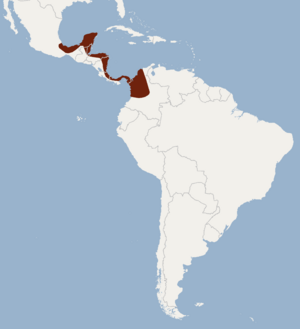Cozumelan golden bat facts for kids
Quick facts for kids Cozumelan golden bat |
|
|---|---|
| Conservation status | |
| Scientific classification | |
| Genus: |
Mimon
|
| Species: |
cozumelae
|
 |
|
The Cozumelan golden bat (scientific name: Mimon cozumelae) is a type of bat. You can find it in several countries in Central and South America. These include Mexico, Guatemala, Belize, Honduras, Nicaragua, Costa Rica, Panama, and Colombia.
For a while, scientists thought this bat was a smaller group (a subspecies) of the golden bat. Not much is known about how this bat lives. However, it lives in many places, and its numbers seem to be stable. Because of this, the International Union for Conservation of Nature says it is of "the least concern" for its survival.
Contents
About the Cozumelan Golden Bat
How it got its name
The Cozumelan golden bat was first described as a new species in 1914. An American zoologist named Edward Alphonso Goldman gave it its name. The first bat studied (called a holotype) was found on Cozumel island. This is how the bat got the "Cozumelan" part of its name.
What it looks like
The Cozumelan golden bat is a medium-sized bat. Its forearm, which is part of its wing, measures about 53 to 59 millimeters (2.1 to 2.3 inches). These bats usually weigh around 35 grams (1.2 ounces).
They have a special set of teeth. Their dental formula is 2.1.2.3 on the top jaw and 1.1.2.3 on the bottom jaw. This means they have a total of 30 teeth.
How it lives
Cozumelan golden bats rest during the day in small groups. They often choose limestone caves as their homes. Sometimes, they also roost inside hollow logs.
These bats hunt for food at night. They are known to "glean" prey, which means they pick insects and other small animals off tree leaves. Their diet includes beetles and katydids. They also eat small birds and lizards.
Breeding for these bats starts when the rainy season begins. Female bats usually give birth to one baby at a time.
Where it lives
The Cozumelan golden bat lives in lowland areas. It prefers to live in forests that are old and well-developed. These can be evergreen forests, semi-deciduous forests (where some trees lose leaves), or dry forests.
Scientists have found these bats at different heights above sea level. They can live anywhere from sea level up to about 600 meters (2,000 feet) high.
See also
 In Spanish: Mimon cozumelae para niños
In Spanish: Mimon cozumelae para niños


